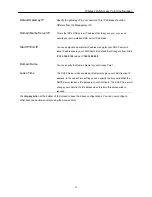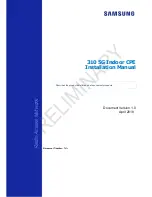
Wireless LAN Access Point Configuration
result in bad performance.
RTS Threshold
When the packet size is smaller than the RTS threshold, the access point will not
use the RTS/CTS mechanism to send this packet.
Beacon Interval
The interval of time that this access point broadcast a beacon. Beacon is used to
synchronize the wireless network.
Data Rate
The “Data Rate” is the rate this access point uses to transmit data packets. The
access point will use the highest possible selected transmission rate to transmit
the data packets.
Preamble Type
Preamble type defines the length of CRC block in the frames during the wireless
communication. “Short Preamble” is suitable for high traffic wireless network.
“Long Preamble” can provide more reliable communication.
Broadcast ESSID
If you enable “Broadcast ESSID”, every wireless station located within the
coverage of this access point can discover this access point easily. If you are
building a public wireless network, enabling this feature is recommended.
Disabling “Broadcast ESSID” can provide better security.
IAPP
If you enable “IAPP”, the access point will automatically broadcast information
of associated wireless stations to its neighbors. This will help wireless station
roaming smoothly between access points. If you have more than one access
points in your wireless LAN and wireless stations have roaming requirements,
enabling this feature is recommended. Disabling “IAPP” can provide better
security.
802.11g Protection
This is also called CTS Protection. It is recommended to enable the protection
mechanism. This mechanism can decrease the rate of data collision between
802.11b and 802.11g wireless stations. When the protection mode is enabled, the
throughput of the AP will be a little lower due to many of frame traffic should be
transmitted.
Click
Apply
button at the bottom of the screen to save the above configurations. You can now configure other advance
sections or start using the Access Point.
27
















































